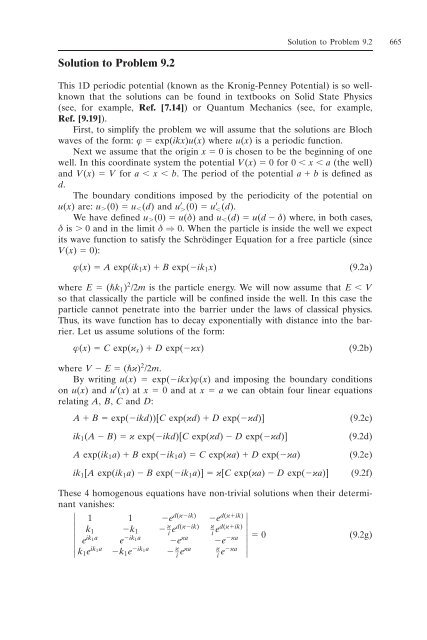10. Appendix
You also want an ePaper? Increase the reach of your titles
YUMPU automatically turns print PDFs into web optimized ePapers that Google loves.
Solution to Problem 9.2<br />
Solution to Problem 9.2 665<br />
This 1D periodic potential (known as the Kronig-Penney Potential) is so wellknown<br />
that the solutions can be found in textbooks on Solid State Physics<br />
(see, for example, Ref. [7.14]) or Quantum Mechanics (see, for example,<br />
Ref. [9.19]).<br />
First, to simplify the problem we will assume that the solutions are Bloch<br />
waves of the form: Ê exp(ikx)u(x) where u(x) is a periodic function.<br />
Next we assume that the origin x 0 is chosen to be the beginning of one<br />
well. In this coordinate system the potential V(x) 0 for 0 x a (the well)<br />
and V(x) V for a x b. The period of the potential a b is defined as<br />
d.<br />
The boundary conditions imposed by the periodicity of the potential on<br />
u(x) are: u(0) u(d) and u ′ (0) u′ (d).<br />
We have defined u(0) u(‰) and u(d) u(d ‰) where, in both cases,<br />
‰ is 0 and in the limit ‰ ⇒ 0. When the particle is inside the well we expect<br />
its wave function to satisfy the Schrödinger Equation for a free particle (since<br />
V(x) 0):<br />
Ê(x) A exp(ik1x) B exp(ik1x) (9.2a)<br />
where E (k1) 2 /2m is the particle energy. We will now assume that E V<br />
so that classically the particle will be confined inside the well. In this case the<br />
particle cannot penetrate into the barrier under the laws of classical physics.<br />
Thus, its wave function has to decay exponentially with distance into the barrier.<br />
Let us assume solutions of the form:<br />
Ê(x) C exp(Îx) D exp(Îx) (9.2b)<br />
where V E (Î) 2 /2m.<br />
By writing u(x) exp(ikx)Ê(x) and imposing the boundary conditions<br />
on u(x) and u ′ (x) atx 0 and at x a we can obtain four linear equations<br />
relating A, B, C and D:<br />
A B exp(ikd))[C exp(Îd) D exp(Îd)] (9.2c)<br />
ik1(A B) Î exp(ikd)[C exp(Îd) D exp(Îd)] (9.2d)<br />
A exp(ik1a) B exp(ik1a) C exp(Îa) D exp(Îa) (9.2e)<br />
ik1[A exp(ik1a) B exp(ik1a)] Î[C exp(Îa) D exp(Îa)] (9.2f)<br />
These 4 homogenous equations have non-trivial solutions when their determinant<br />
vanishes:<br />
<br />
<br />
1<br />
<br />
<br />
<br />
<br />
<br />
1 ed(Îik) ed(Îik) k1 k1 Î<br />
i<br />
ed(Îik)<br />
Î<br />
i ed(Îik)<br />
eik1a eik1a eÎa eÎa <br />
<br />
<br />
<br />
<br />
0<br />
<br />
<br />
(9.2g)<br />
k1e ik1a k1e ik1a Î<br />
i eÎa<br />
Î<br />
i eÎa










